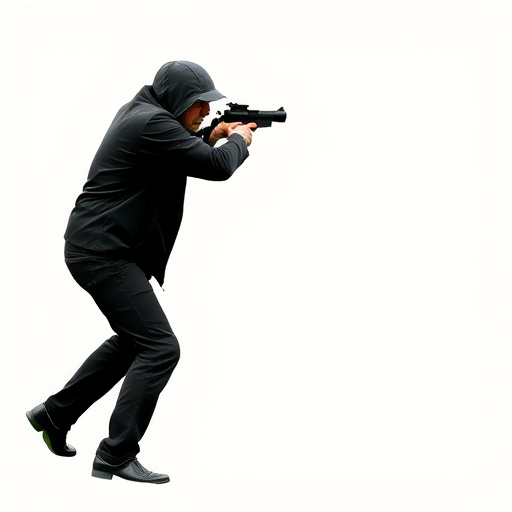The science behind bear spray revolves around capsaicin and pepper compounds that irritate bears' sensory organs. Effective usage involves aiming for the bear's face at a close range (3-4 feet) with direct aiming for 2-3 seconds after swift deployment. Best practices include regular maintenance, inspections, training, and strategic targeting of sensitive areas during encounters. Mastering these techniques ensures optimal protection when combining bear spray with other safety measures.
“Uncover the power of a handheld pepper spray defense unit, your ultimate tool for personal safety. This comprehensive guide explores the essential aspects of bear spray, from understanding its active ingredients and potent effects to mastering the best application techniques. Learn how to effectively navigate dangerous encounters, ensuring your safety in the wild. Discover optimal range, deployment strategies, and vital maintenance tips to keep your defense unit ready when you need it most. Embrace the knowledge and confidence that come with being prepared.”
- Understanding Bear Spray: Active Ingredients & Effects
- Best Practices for Safe and Effective Application
- Range & Reach: Knowing When and How to Deploy
- Maintenance & Safety Tips for Your Handheld Defense Unit
Understanding Bear Spray: Active Ingredients & Effects
Understanding Bear Spray: Active Ingredients & Effects
Bear spray, also known as bear deterrent or bear repellant, is a specialized pepper spray designed to protect individuals from aggressive bears. The primary active ingredients in effective bear sprays are capsaicin and other pepper-based compounds. These substances stimulate the bear’s sensory organs, particularly the eyes and nose, causing them to react by moving away from the source of irritation. The most potent bear sprays contain concentrations of capsaicin ranging from 15% to 24%, ensuring maximum effectiveness when deployed correctly.
The best bear spray application techniques involve aiming for the bear’s face, specifically its eyes, nose, and mouth. Spraying directly at these areas ensures direct contact with the sensitive mucous membranes, leading to a quicker and more effective response from the bear. It’s crucial to remember that bear spray is not a cure-all; it works best as a deterrent when used in conjunction with other safety measures like making noise, appearing larger, and slowly backing away while facing the bear.
Best Practices for Safe and Effective Application
When using a handheld pepper spray defense unit, adherence to best practices is crucial for safe and effective application. Start by assessing the threat level and targeting specific areas like the face, eyes, and nose, which are highly sensitive. Aiming accurately is key; hold the canister at close range (around 3-4 feet) and point directly at the target to maximize impact while minimizing collateral damage.
Use a swift, decisive motion to deploy the spray, ensuring a continuous stream for the recommended duration (typically 2-3 seconds). Maintain distance after application to avoid cross-contamination from residual pepper spray. Regularly inspect and maintain your defense unit to ensure optimal performance, including checking expiration dates and cleaning the nozzle. Proper training and familiarity with the device’s mechanics are essential to reacting swiftly and effectively in real-life situations.
Range & Reach: Knowing When and How to Deploy
Understanding the range and reach of your handheld pepper spray defense unit is crucial for effective deployment. These devices typically have a range of 2-3 meters, which means it’s best used in close to medium encounters where direct contact or escape may not be immediately possible. The key to successful use lies in knowing the distance at which you can effectively deploy it to disrupt an attacker and create an escape route.
When considering the best bear spray application techniques, remember that aiming for the face is crucial. Targeting the eyes, nose, and mouth areas will cause temporary but intense disorientation, allowing you to back away or escape. Practice makes perfect; consider training scenarios with a trusted partner to ensure accurate deployment when it matters most.
Maintenance & Safety Tips for Your Handheld Defense Unit
Proper maintenance is key to ensuring your handheld pepper spray unit remains effective and reliable when you need it most. Regularly inspect the canister for any signs of damage or corrosion, especially after extreme temperature changes or rough handling. Keep your device stored in a cool, dry place, away from direct sunlight, as heat can cause the canister to expand and potentially trigger prematurely.
When it comes to safety, understanding the best bear spray application techniques is vital. Aim for the face and eyes, as pepper spray is most effective at this range. Move quickly and create a barrier between yourself and the bear by raising your arms overhead. Remember, practice makes perfect, so familiarize yourself with the spray pattern and range to maximize its impact during an encounter.
Handheld pepper spray defense units, or bear sprays, are powerful tools when faced with potential wildlife encounters. By understanding the active ingredients, best application techniques (Best Bear Spray Application Techniques), and range limitations, users can effectively protect themselves while enjoying the outdoors. Regular maintenance and safety practices ensure these devices remain reliable in times of need. Remember, knowledge is key; always stay informed about local regulations and be prepared for any scenario when venturing into bear country.
